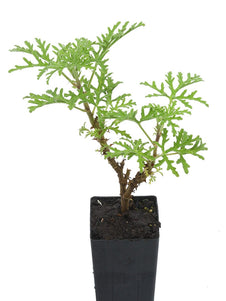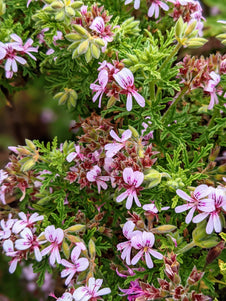









Scented Geranium Candy Dancer
Scented Geranium Candy Dancer

- In stock, ready to ship
- Inventory on the way

Usually available: April to November
Life cycle: Perennial
Height: 70cm
Position: Sun / part shade
Soil preference: Well drained
This is how we pack and send your Herb Plants to all states except TAS & WA
You will receive
- 1 Scented Geranium Candy Dancer Herb Plant in a 50 X 75mm tube - General growing instructions
All of our Herb Plants are grown organically with certified organic potting mixes and fertilizers
Botanical Name: Pelargonium 'Candy Dancer'
Candy Dancer Scented Geranium is a small, compact shrub growing to approximately 70 cm wide and 70 cm high. It has an upright, semi-arching growth habit with dense foliage cover. The leaves are a mid-green colour and quite lace or fern like in appearance. They are deeply divided and have serrated edges. The flowers are lavender to mauve and flowers over a long period. The rich scent is of ‘candy and roses’ or may be described as rose with lemon undertones.
The plant is quite robust and benefits from being pinched out in the early stages of growth to maintain shape. This variety is one of the many scented rose geraniums available and was developed from the parent Pelargonium graveolens. It shares many similar growing requirements and practical uses.
Pelargonium General Notes
Pelargoniums are evergreen perennials, sharing many common characteristics with the Geranium species. They range in height from 30- 100cm and may be categorized based on varying leaf shapes, such as crinkled, oak or fern leaf shapes. The leaf colour may vary from deep to light green, with flowers generally held in loose clusters. Most prefer to grow in full sun and they are also drought and heat tolerant. However, some varieties do require some shade and moist conditions where possible. Many grow near streams in their native habitats, but generally ‘less is more’ is a good guideline for watering these plants. They do not like to be damp at all.
This group of plants were initially catalogued by Linnaeus into the same Genus as Geraniums, but were separated into separate genera in 1789. Pelargoniums were taken to England in 1631, but it is likely they were transported to Holland in the earlier 1600’s. Since early times various varieties have been developed and many are now cultivated commercially for the essential oils used in perfumery and aromatherapy.
The Pelargonium genus is one of five in the family Geraniaceae, which has over 800 species. This includes the separate Geranium genus, which often causes confusion since ‘geranium’ is also used as a common name for the many Pelargonium species and cultivars. There is thought to be 270 species of Pelargonium, with 219 being native to South Africa. Among these, there is a number of genera or subtypes of pelargonium based on features such as leaf type. Of this selection about 80% are native only to select areas in the southern regions of South Africa. The remaining 20% are found in Australia, New Zealand and a few select areas such as Madagascar and Eastern Africa. There are now cultivated varieties all over the world, most with origins in South Africa. The true Geranium species is a hardy group of plants native to North America and Europe.
The Geranium plant family is an important food source for certain Lepidoptera species in their native regions. For more information on our other Scented Geranium listings.
Growing Conditions
Scented Geranium ‘Candy Dancer’ grows in full sun and requires a well-drained soil. It has average water requirements and should be drought tolerant once established.
Most pelargoniums enjoy full sun, but the parent plant Rose Scented Geranium is one variety that requires more shelter. Pelargonium graveolens grows very well in semi-shaded positions and is good as a filler plant in larger gardens. It requires a moist, but not damp environment, with well- drained soil. These factors are useful when deciding where to plant varieties developed from P. graveolens.
This plant also grows well in containers and hanging baskets, but ‘Candy Dancer’ can grow large and may need pruning if in a container. In cold regions it may even be taken indoors, but may be better treated as an annual if this is not possible. Although, not very tolerant of frost some plants may die down and return when the weather warms in spring. It may be propagated by tip or stem cuttings taken in autumn or spring. Seed may be sown at almost any time of the year, especially in warmer climates.
Culinary Uses
Pelargoniums are usually suitable for culinary use, particularly the leaves and flowers. They may be used for herbal teas and to sweeten and scent desserts such as cakes and jelly. The most commonly used are those with rose, lemon and peppermint scents. Leaves may be cut and placed in ice cube trays for later use in iced tea or other suitable cold drinks. Scented Geranium ‘Candy Dancer’ is an excellent companion in the kitchen, where the lovely rose- lemon scent is a welcome addition to many recipes.
A tea infusion may be made using 3 teaspoons of freshly chopped leaves, or 1 teaspoon of dried leaves, and 1 cup (250mls) of boiling water. Let the leaves steep, strain and then drink as needed. There are several varieties suitable for a tea infusion, but it may be a matter of taste.
Medicinal Uses
Many South African varieties of Pelargonium have a history of traditional medicine use by local tribes. General traditional use has included treatment for digestive and respiratory ailments, wounds, burns, ulcers and abscesses, cold sores and sore throats. The active chemicals are slightly astringent so they are good for skin care, oily skin and cleansing the pores. Overall the pelargonium species are seen as having value for creating a relaxing and uplifting feeling, while calming nerves, anxiety and aiding depression. There is also value for use in premenstrual tension and for those seeking an essential oil for creating a soothing and balancing effect on the body. Different varieties may have different effects.
The strongly scented Rose Scented Geranium, Pelargonium graveolens, is one of the best plants in this genus for traditional medicine use. Several active chemicals, in this species, have been determined to be beneficial for having antibiotic effects and nerve pain relief. Research has indicated it is helpful for nerve pain associated with shingles. It is thought to also have a soothing effect on the skin when used to bath rashes, skin irritations or simply used in bath water.
Other Uses
Many of the scented pelargonium species and varieties are cultivated especially for their use in perfumery, aromatherapy and massage therapy. Rose Scented Geranium is often used as a substitute for the more expensive Rose of Attar. The oil is extracted from the leaf and stems of the plant. Like many of the Scented Geraniums, ‘Candy Dancer’ is ideal for adding to bath water creating a relaxing and rejuvenating environment.
All information provided on this website is for informational purposes only. Please seek professional advice before commencing any treatment.





